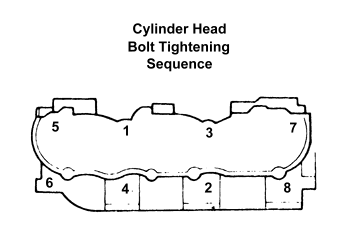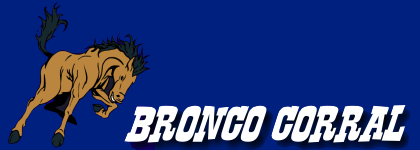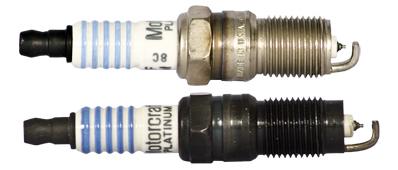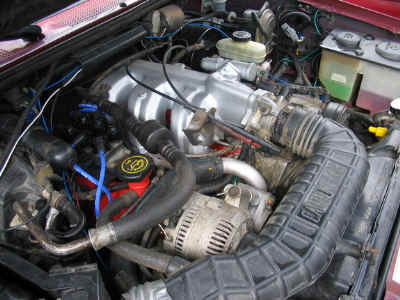
The 4.0L OHV (Over Head Valve) V-6 engine found its way in to the Ford Ranger in 1990 and ultimately replaced the 2.9L V-6. Information on this engine is being provided because many Bronco II owners have swapped it in to their Bronco II.
This evolutionary redesign of the American 2.9L solved many of the reliability issues that plagued its predecessor. A beefier cylinder head design eliminated the 2.9L’s common failure of cracked heads. Hydraulic roller lifters replaced the simple hydraulic lifters used in the 2.9L, which were sometimes overly sensitive to oil contamination, often requiring the lifters to be replaced prematurely. However, one major design fault was not completely eliminated: Valve rockers and upper pushrod tips still received poor oil supply, resulting in eventual wear to these areas, and consequential valvetrain noise as a result of the increased clearance. Required replacement of these parts is common in older engines.
The 4.0L OHV engine was produced until 2000 and was used in the Ford Explorer and Ranger. Output was 160hp and 225 ft·lbf. Though there is some variation, typically 155hp is quoted as horsepower for 1990-1992 applications.
In 1998 the 4.0L SOHC (Single Over Head Cam) engine replaced the 4.0L OHV engine producing 207hp.
SOHC & OHV Engine Differences:
The difference between a SOHC 4.0L and OHV 4.0L is that in a SOHC engine there is a camshaft sitting on the top of each cylinder head with the valves running directly off the camshaft. It doesn’t rely on push rods, rocker arms, or lifters. The SOHC engine uses a jackshaft in place of a camshaft to drive a timing chain to each cylinder head. Three timing chains are used, one from the crank to the jackshaft, one in the front of the engine to drive the cam for the left bank, and one on the back of the engine to drive the cam for the right bank.
The OHV engine has the cam mounted above the crank. The cam and crank are joined in time by a timing chain. Lifters ride on the cam and push rods that extend to rocker arms in the heads which push the valves.
| Specifications | |
| Engine Displacement (Cubic Inches) | 245 CID |
| Type | OHV (1990 – 2000) (VIN Code X)
SOHC (2001 – 2007) (VIN Code E) |
| Bore x Stroke | 3.95 x 3.31 inches |
| Compression Ratio | 9.0:1 |
| Fuel System | Sequential Fuel Injection |
| Fuel Pressure | 39 – 40 PSI (30 PSI @ idle) (OHV Engines)
64 – 75 PSI (SOHC Engines) |
| Horsepower | 160 hp @ 4200 RPM (1990 – 2000)
207 hp @ 5250 RPM (2001 – 2007) |
| Torque | 220 @ 2400 RPM (1990 – 2000)
238 @ 3000 RPM (2001 – 2007) |
| Oil Pressure | 40 – 60 PSI @ 2000 RPM |
| Tune Up | |
| Spark Plug (Motorcraft)Important Note: The SOHC spark plug is about 1/4 inch longer then that of the OHV. The OHV plug will fit but it won’t operate properly.
(OHV spark plug at the top – SOHC plug on the bottom) |
1990-1996 uses SP486 (Platinum) (old part number is AWSF42P)
1997-2000 uses SP500 (Platinum) (old part number is AGSF22PP) or SP413 (Premium Nickel) 2001-2005 uses SP498 (Platinum) (old part number is AGSF34FP) or SP412 (Nickel) |
| Spark Plug Gap | 0.054 inches |
| Ignition Timing | 10 degrees BTDC |
| Firing Order | 1-4-2-5-3-6 |
| Capacities | |
| Oil Capacity With Filter Change | 5 Quarts (OHV Engines)
5 Quarts (SOHC Engines) |
| Cooling System Capacity (Quarts) | With A/C 7.2 quarts
Without A/C 6.5 quarts (OHV Engines) 13.2 Quarts (SOHC Engines) |
| Torque Specifications | |
| Cylinder Head | Torque in 3 steps (OHV Engines):
Torque in 2 steps (SOHC Engines):
|
| Main Bearing Bolts | 66-77 ft-lbs (OHV Engines)
72 ft-lbs (SOHC Engines) |
| Rod Bearing Bolts | 19-24 ft-lbs (OHV Engines)
Torque in 2 steps (SOHC Engines):
|
| Crankshaft Pulley Bolts | Torque in 2 steps (OHV Engines):
Torque in 2 steps (SOHC Engines):
|
| Flywheel to Crankshaft Bolts | 59 ft-lbs (OHV Engines)
75-85 ft-lbs (SOHC Engines) |
| Lower Intake Manifold / Throttle Body | Torque in 4 steps (OHV Engines):
7 ft-lbs (SOHC Engines) |
| Exhaust Manifold | 19 ft-lbs (OHV Engines)
16 ft-lbs (SOHC Engines) |
4.0L Firing Order

4.0L Engines Firing Order: 1-4-2-5-3-6 DIS Ignition System
Known Problems:
Missing or Bogging – There are several things that could be causing this. First off your MAF may be dirty. Check HERE on how to clean it. Then there are the obvious – plugs, wires, dirty injectors. Tune up items basically.
Also, if you get a problem with hesitation, check the wires around the exhaust. One of the oxygen sensor wires may have been damaged by the exhaust.
Loose Intake Manifold Bolts – Some 90’s 4.0L’s have a problem with loose intake bolts. Click HERE for more details.
How To Build Performance:
Check this article on ‘How To Build A Ford 4.0L OHV For Power‘.
Performance Parts:
Tom Morana: Offers numerous products for the 4.0 including stroker kits, camshafts, connecting rods, pistons, cylinder heads, and supercharger kits.
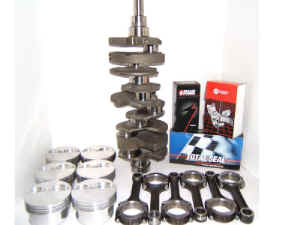
4.0 Stroker Kits
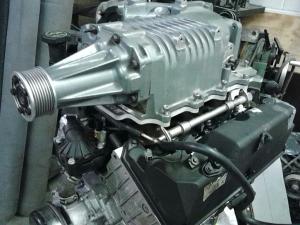
4.0 Supercharger Kit
K&N Filters: Carries products including new air intake systems for some 4.0L Rangers.
Camcraft: Offers a new camshaft for the 4.0L.
Super Six Motorsports: Offers cylinder heads for the 4.0L engines.
Competition Cams: Offers camshaft# 49-410-8 as an OEM replacement good for towing and all around performance. Camshaft# 49-422-8 is a more aggressive cam for 4.0’s with other modifications. It is designed to improve midrange power and torque.
Thomas Knight: Offers a kit to install an Eaton supercharger on the 4.0L Ranger.
BBK Performance: BBK offers 66mm throttle bodies for the 4.0L OHV Ranger.
Pacesetter: Pacesetter offers headers for the 4.0L OHV Ranger.
JBA: JBA offers headers and ignition wires for the 4.0L Ranger.
Hedman Hedders: Offers headers for the 4.0L engines.
Nitrous Oxide Systems (NOS): Nitrous Oxide Systems (NOS) showed the world how to effectively harness the power of nitrous oxide for automotive use in the 1970’s. Since then, NOS has powered more racers than any other brand of nitrous. When you’re looking to go fast, rely on NOS to deliver the most power per dollar available. From stock engines to race vehicles, jet skis to trucks, NOS has a kit for you.
Modifications:
Head Porting:
Port your upper and lower intake. The intakes don’t line up diameter to diameter. Porting opens this up and allows better flow. Knife edge the intake side of the throttle body to remove the front lip. You can use a Dremel tool to grind, sand and buff this area to obtain a smooth airflow in to the engine. You can also mill down the butterfly to blend in to the shaft for a smoother air flow.
For details on how to port your heads, click HERE.
Ignition:
MSD – Manufactures a DIS ignition system along with wiring harnesses. Find their parts at Summit Racing.
JetChip – Makes a module to reprogram the engines computer. Click HERE.
4.0 Computer Numbers Submitted by: skineral
1991 Explorer 4.0 Manual Transmission 4×4
Calf 3006 (F07F-12A650-YA) & (F07F-VAMR)
Fed 3007 (F07F-12A650-VA) & (F07F-VAMR)
1992 Explorer 4.0 Manual Transmission 4×4
Calf 3397 (F27F-12A650-VC) & (F27F-12A650-VCMR)
Fed 3398 (F27F-12A650-TC) & (F27F-12A650-TCMR)
1993 Explorer 4.0 Manual Transmission 4×4
Calf 3729 ( F37F-12A650-XB) & (F37F12A650-CRA)
Fed 3726 (F37F-12A650-UC) & (F37F-12A650-YR) & (YMBR)
1990 Ranger 4.0 Manual Transmission 4×4
Calf 3064 (F07F-12A650-P1A)
Fed 3065 (F07F-12A650-M1A)
1991 Ranger 4.0 Manual Transmission 4×4
3065 (F07F-M1A)
3256 (F17F-ADA)
1992 Ranger 4.0 Manual Transmission 4×4
3433
1993 Ranger 4.0 Manual Transmission 4×4
3723 (F37F-LA)
Cylinder Head Diagrams:
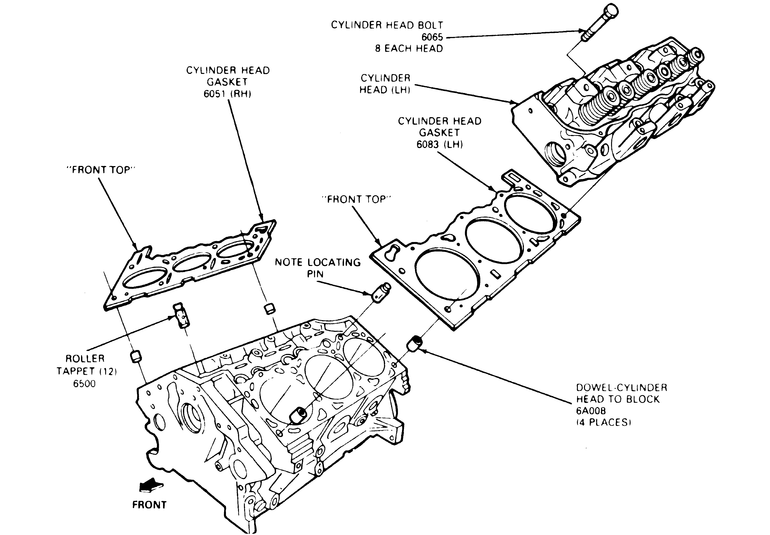
4.0 OHV Cylinder Head Install
